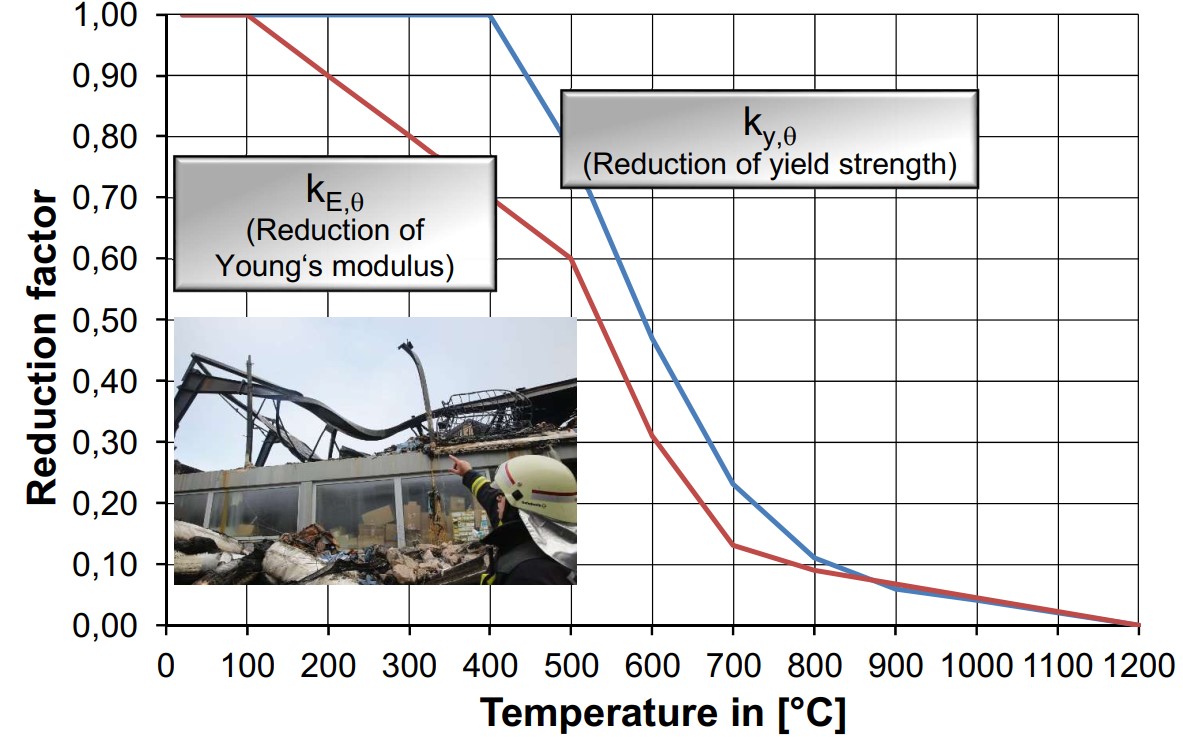Critical temperature of fire-exposed steel
Fire behaviour of steel
How does steel behave at high temperatures, for example when exposed to fire? Steel is non-combustible and only melts at temperatures of approx. 1400°C (with a carbon content of about 2%). Even the ISO standard fire (the relevant fire curve for determining the fire resistance in constructions) does not attain these high temperatures. Thus, steel usually does not "melt" in the event of a fire. As always, exceptions confirm the rule as there are even more unfavourable fire room curves with higher temperatures in addition to the ISO standard fire. These are for example the tunnel fire curve as well as the hydrocarbon curve for fires (e.g. for fires on oil platforms).
Why do you hardly see unprotected steel structures in constructions? This is due to its very high thermal conductivity, which for steel is approximately λ=50 W/(m*K). This is about 25 times higher than that of concrete. As a result, steel structures (such as steel columns or steel beams) heat very quickly in the event of a fire.

At what temperature does steel lose its strength?
Often designers know that a critical temperature of steel is 400°C. As can be seen in the diagram above, this temperature refers to the reduction of the yield strength, i.e. the loss of strength of steel at high temperatures. Thus, this temperature may be regarded as critical for constructions that are not prone to stability problems, such as tension members in trusses.
By the way, when you enter a temperature in the table below, the interpolated values for the reduction factors ky,Θ (yield strength) and kE,Θ (Young's modulus) become automatic identified for you.
However, in steel construction members are often slender and hence prone to stability problems, e.g. steel columns in industrial halls. In this respect, the temperature-dependent reduction of the Young's modulus is of great importance. As can be seen in the diagram, the elasticity of the structural steel decreases even at temperatures exceeding 100°C. This is the reason why fires in industrial halls often lead to partial or total collapse of the structure due to stability problems.
Structural fire design according to Eurcodes
The thermal and mechanical material constitutive laws of fire-exposed structural steel can be found in EN 1993-1-2. The Eurocodes ending "1-2" are also called the "hot" Eurocodes because they deal with the material characteristics of concrete (EN 1992-1-2), structural steel (EN 1993-1-2), steel composite construction (EN 1994-1-2) and wood (EN 1995-1-2) under fire conditions.
These material laws are implemented in special programs for the fire design of members (also called fire design). The programs use the thermal material characteristics in the thermal analysis, while they use the mechanical material characteristics for mechanical analysis.
How I can help you.
I can offer you a short-term fire design for your given task in the European Union or worldwide. The documentation contains the essential information on the heating of the cross-section, the fire resistance of the member or structure as well as its deformations. I can of course provide further services so do not hesitate to contact me.
What are your benefits?
My clients often save costs by using sophisticated fire design. In the case of new buildings, leaner and therefore more economical constructions can be carried out. In the case of existing structures extensive upgrading measures can often be avoided by an accurate fire design.
My initial consultation for your project
To clarify your specific task, it is best to call me. Or you can send me an e-mail with some key data. On this basis, we can discuss the framework conditions and I can create an attractive offer for you.